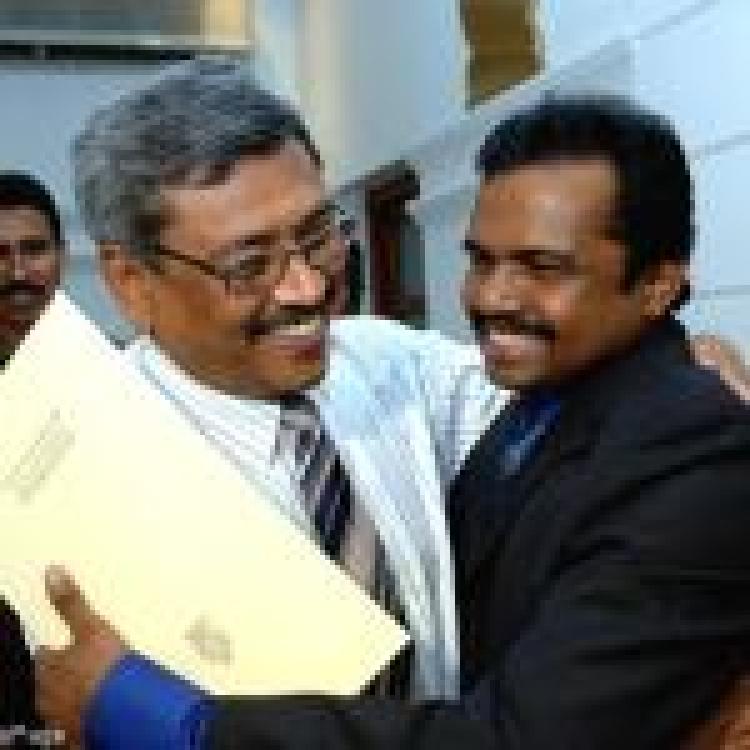![]()
Writing on Vinayagamoorthy Muralitharan’s (aka Karuna Amman) recent boast, that under the LTTE he had killed “2,000 – 3,000 soldiers” during the attack on elephant pass, Tissainayagam notes that this statement “shattered an alternate reality Sri Lanka has tried to create about the country’s civil war” and its post-war order.
For this constructed reality, Karuna had served two purposes, argues Tissainayagam;
“As a symbol of purported national reconciliation, with a covert intention of promoting Sinhala interests, and to help build an alternate narrative about the civil war favourable to the Sinhala elite”.
Karuna’s role in the war
Karuna had joined the LTTE in the 1980s and risen through the ranks. The battle at Elephant Pass in April 2000, is among the battles he claims to have participated in and he touts his success at overthrowing the Sri Lankan garrison.
During the ceasefire, declared in December 2001 due to heavy losses in both sides, Karuna played a fairly important role. However, Tissainayagam notes that in late 2003, Karuna defected after being summoned to northern headquarters by LTTE leader Velupillai Prabhakaran on charges of corruption. Karuna alleges that LTTE cadres in the East suffered discrimination by those from the North, and he subsequently proposed a semiautonomous command with him as the head.
This divide with the LTTE was further complicated during peace negotiations wherein 2004, Prime Minister Ranil Wickremesinghe’s government allegedly engineered Karuna’s evacuation from the cordon set up by Prabhakaran’s loyalists. This decision undermined the peace negotiations.
Following this Karuna established a paramilitary group which was backed by government forces in combatting the LTTE. This paramilitary group engaged in the extra-judicial killings of civilians, including a former parliamentarian.
In November 2005, Mahinda Rajapaksa became president, and Karuna switched alliances to his party. A US embassy cable from May 2007 reveals that Karuna’s paramilitaries extorted money from Tamil businessmen on the advice of then Defence Secretary Gotabaya Rajapaksa.
Tissainayagam notes that Karuna had “unleashed an orgy of violence mainly against Tamils in the Eastern Province by recruiting child soldiers and abducting and disappearing civilians in Colombo, with the support of the then government”.
In 2007, Karuna was permitted to transform his paramilitary into the political party known as the Tamil Makkal Viduthalai Puligal (TMVP). Karuna was a puppet for the Rajapaksa administration and took a seat in the legislature.
The post-war order
Following the brutal end to the civil war, in which at least 40,000 were killed, the Rajapaksa administration resided over the new post-war settlement and chose to consolidate Sinhala hegemony in Sri Lanka as well as discipline Tamils for supporting secession.
Disciplining Tamils
“The disciplining included torturing Tamil civilians in internment camps, killing or disappearing many ex-LTTE cadres and potential civilian community leaders and, long-term, laying the foundations for the militarization of northeastern Sri Lanka” Tissainayagam writes.
Tissainayagam further states;
For Rajapaksa, “Sinhala-Tamil reconciliation […] had to be in an environment where the Tamils are militarily and politically suppressed […] This meant that those who executed the repression – the Sinhala military and politicians – had to remain hegemons and hence not subject to accountability for wartime atrocities or violations in the post-war era. Since Tamils had to be punished collectively for supporting the armed rebellion, Sinhalese and Tamils sharing political power weas ruled out. In this context, the only ‘reconciliation’ the Rajapaksa government could promote was through subservient Tamil individuals – loyalists like Karuna”.
Whilst Tamils were collectively punished for their support of secession, figures like Karuna were allowed certain advantages and rewards.
“He was not only made minister of national integration and reconciliation in March 2009 but persuaded to abandon the TMVP and join the United Peoples’ Freedom Alliance, led by Mahinda Rajapaksa”, Tissainayagam writes.
The message was clear, Tamils were told to abandon their political demands and to reintegrate into society as a “second-class citizens”.
The post-war narrative
Tissainayagam notes that it was not Tamils who exception to his words but rather the Sinhala public which are “anxious to forget some embarrassing moments in the past”.
The Sri Lankan government are wary of mention military defeats and instead emphasis the events that “that led to the death of Prabhakaran and overrunning of the area defended by an enfeebled LTTE”.
Karuna in the past has been more than happy to assist this narrative by disparaging the LTTE, describing “Prabhakaran’s policies as ‘totalitarian’ and deriding the LTTE’s military successes”. However, these recent remarks broke from this narrative, and contradicted “what he had contributed for over a decade towards building the narrative Sri Lankan political leadership wanted”.
Whilst the Sinhalese, especially the elite, had begun to believe their own constructed narrative, it is telling that Karuna’s appeal to Tamil voters was not centred on denigrating the LTTE. Instead, Karuna appealed to Tamil pride, “which despite the defeat, is even today centred on the armed struggle”. He wanted to “reminded his audience of that struggle and the heroic part he claimed to have played in it”.
Tissainayagam concludes stating:
“If what appeals to Tamils is that ‘Karuna killed 2,000-3,000 Sri Lanka soldiers in one night’ rather repeating, puppet-like, sentiments belittling the LTTE that the Sinhala elite expected from Karuna and which he had dutifully done for over a decade, it also showed the failure of another aspect of the post-war pacification. It demonstrated that consolidating Sinhala interests in the guise of national reconciliation, where other groups and peoples are treated subordinate – as ‘minorities’ – was not leading to either nation-building or integration. It was only perpetuating the cleavages".
Read more from International Policy Digest.




